|
FORGOTTEN
WRITERS #1 : Jay / J.M. Flynn
by Bill Pronzini Jay Flynn was a character. The tragicomic variety, with accent on the tragic. In many ways he was a throwback, a stereotype. Hard-drinking, rough-living, blarney-spouting Boston Irishman. Ex-GI, newspaperman (ten years as a crime reporter on the Portland Express, Portland, Maine; stints on the San Jose Mercury and other California papers), bartender, editor, mystery writer, sex novelist, bootlegger, security guard, caretaker, and (so he claimed) prisoner in a hell-hole Mexican jail on a trumped-up charge and “writer-in-residence” at a Nevada whorehouse. A screw-up of the first rank, with sometimes hilarious results. Lousy luck with women and games of chance, much of it of his own making. Restless, peripatetic; “everybody’s got to be someplace,” he said once, “but it don’t always have to be the same damn place.” Lazy, ambitious, apathetic, energetic, generous, selfish, cynical, sentimental, don’t-give-a-damn, care-too-much – all the schizophrenic contradictions that make up most of us, but that in him seemed magnified to an even greater degree. As has been said about Hemingway, he was just a little larger – and just a little smaller – than life. There is a schizophrenic quality to his fiction as well. He was like the proverbial little girl: When he was good he was very good, but when he was bad he was very, very bad. His characters and his plots, like Flynn himself, were full of BS and on the screwball side. Big, tough, occasionally inept Irish heroes with names like McHugh, Tighe Slattery, Joe Mannix (no relation or resemblance to the Mike Conners TV character), Burdis Gannon, Matt Tara, Burl Stannard, John Christian Fifer. 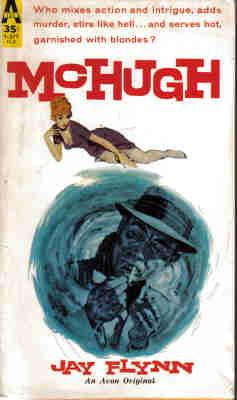 Beautiful, willing,
treacherous women. Ultra-nasty
villains. Action fast and furious – and scatterbrained and
often implausible. Storylines, some solidly constructed and some
riddled with holes, involving elaborate capers, hijackings, modern-day
bootlegging, the hot-car racket, military-base intrigue, the Mafia,
vigilante cops and serial killers, Nazi war spoils, spy stuff, even a
treasure hidden inside an Irish pub’s thirty-foot, hand-carved mahogany
bar. Typical paperback fare of the sixties and seventies, in one
sense; atypical, in another, because of Flynn’s slightly skewed
perceptions and not inconsiderable (when he worked at it) storytelling
skills. Beautiful, willing,
treacherous women. Ultra-nasty
villains. Action fast and furious – and scatterbrained and
often implausible. Storylines, some solidly constructed and some
riddled with holes, involving elaborate capers, hijackings, modern-day
bootlegging, the hot-car racket, military-base intrigue, the Mafia,
vigilante cops and serial killers, Nazi war spoils, spy stuff, even a
treasure hidden inside an Irish pub’s thirty-foot, hand-carved mahogany
bar. Typical paperback fare of the sixties and seventies, in one
sense; atypical, in another, because of Flynn’s slightly skewed
perceptions and not inconsiderable (when he worked at it) storytelling
skills.His first published work and only published short story, “The Badger Game,” as by Jay Flynn, appeared in the November 1956 issue of the hard-boiled, J.D.-oriented mystery magazine, Guilty; his first novel, The Deadly Combo, as by J. M. Flynn, was an Ace Double two years later. The short story isn’t such-a-much; the novel is a pretty fair maiden effort. There is a similar dichotomy among his six other Ace Doubles published between 1959 and 1961, all as by J. M. Flynn. Four are varying degrees of good: The Hot Chariot, Ring Around a Rogue, Drink with the Dead, The Girl from Las Vegas. The other two, One for the Death House and Deep Six, are rather awful. His best novels of the period are a pair of capers, Terror Tournament and The Action Man, and the five titles that comprise his series featuring an off-the-wall San Francisco bar owner and secret agent named McHugh. Terror Tournament (Bouregy, 1959, his only hardcover) is an effective tale of the carefully planned heist of the gate receipts of a golf tournament modeled after the one at Pebble Beach. Even better – his magnum opus, in fact – is The Action Man (Avon, 1961, as by Jay Flynn). The caper here is a bank heist, and its mastermind, anti-hero Denton Farr, is Flynn’s most complex and believable protagonist. A high level of suspense and a savagely ironic ending are two of the novel’s other pluses. 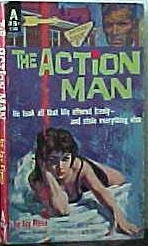 If Denton Farr is Flynn’s most complex and believable character, McHugh is his most memorable. In McHugh, A Body for McHugh, It’s Murder McHugh, Viva McHugh!, and The Five Faces of Murder (Avon, 1959-62, all as by Jay Flynn), this two-fisted Irish-American James Bond blithely brawls and blusters his way through dizzy plot-swirls concerning a missing electronics expert, Mafia hit men, a couple of Navy flyers mysteriously AWOL in Mexico, a Caribbean island dictator and his army of thugs, and a fortune in hidden Nazi loot. Along the way he drinks prodigious amounts of booze, trades quips with his fellow agent, Bud Chapman, and his boss, General Burton Harts, and has more problems than sack time with bevies of good and bad women. None of his adventures make much sense, really, but there is a good deal of energy in each, plus plenty of sly humor, breakneck pacing, and some lean, evocative writing. As in the barbed narrative hook that opens It’s Murder McHugh: McHugh pushed the Polish girl away and
went on watching the door of the cantina. He wished Bramhall
would show up. It would be even better if Long was with him.
That would make his job easier, because he could kill both of them at the same time. (Flynn once told me that the McHugh series was the result of a drunken lunch with his agent and an editor at Avon. The agent, he said, began extolling the virtues of “a great new series” Flynn had concocted, and did such a good selling job that afterward the three of them lurched back to the Avon offices, where the editor immediately put through a request for a three-book contract. The only problem was, Flynn had not concocted anything at this point; had never heard the name McHugh until his silver-tongued agent mentioned it, nor had any idea of who or what McHugh was going to be. This anecdote may be true and it may be apocryphal. With Flynn, you just never knew what was fact and what was bullshit.)  I read most of
his Ace and Avon novels, either when
they were first published or at some point in the sixties. One
of my favorites was Drink with the
Dead, which has a modern-day bootlegging theme, and in early
1969 I recommended it to friend and fellow writer Jeff Wallmann.
Jeff liked it so much he suggested we write a story with a similar
theme, which we proceeded to do. The result, “Day of the Moon,”
was published in Alfred Hitchcock’s
Mystery Magazine in 1970 under our William Jeffrey
pseudonym. Much later, we expanded the story into a novel that
was published under the same title and same pseudonym. I read most of
his Ace and Avon novels, either when
they were first published or at some point in the sixties. One
of my favorites was Drink with the
Dead, which has a modern-day bootlegging theme, and in early
1969 I recommended it to friend and fellow writer Jeff Wallmann.
Jeff liked it so much he suggested we write a story with a similar
theme, which we proceeded to do. The result, “Day of the Moon,”
was published in Alfred Hitchcock’s
Mystery Magazine in 1970 under our William Jeffrey
pseudonym. Much later, we expanded the story into a novel that
was published under the same title and same pseudonym.One evening after we’d written the story, over too many drinks in Wallmann’s house near San Francisco, we got to talking about Flynn and his work; to wondering why he hadn’t published a new novel in seven years; and whether or not he was still living on the Monterey Peninsula, where much of his fiction was set and where a brief bio in one of the Ace Doubles said he made his home. As a lark, we began that night to track him down. It took us a while, following a cold and circuitous trail, but we finally found him – not on the Monterey Peninsula but in a V.A. facility in Portland, Maine. On the phone he claimed to be recuperating from a buckshot wound – in the ass, no less – administered by an irate husband. He also claimed to be writing a new McHugh novel to pay his medical expenses, which proved definitely to be hooey because no such book was ever published. That was Flynn. I exchanged a couple of letters with him shortly afterward, but at that point none of us seemed inclined to keep up a regular correspondence. It would be almost two years before Wallmann and I got to know Flynn well. And how that came about requires a couple of paragraphs of relevant autobiography. In mid-1969 Jeff and I succumbed to an offer to write sex books for an outfit called Liverpool Library Press, aka LLP – partly for the money, which was top market dollar in those days ($1200 per title), and partly because it enabled us to finance our legitimate work. Soon we were collaborating on a book every two months for LLP. We churned them out in four or five days of intensive effort, so we could spend the rest of our time writing fiction we cared about. Late that year LLP moved its base of operations from California to the Mediterranean island of Majorca, where the high-rolling publisher (an Ivy-League American) had rented a palatial villa. For tax and other reasons he preferred his writers to also live on Majorca – or at least somewhere in Europe – and so he offered to pay the way of anyone who was willing to make the move. Wallmann and I were willing. We took a freighter for Amsterdam in February of 1970, and we arrived on Majorca in a broken-down VW station wagon five weeks later. Neither of us remembers corresponding with Flynn while we were on Majorca; and we have only dim recollections of receiving some kind of communication from him at Christmas of 1970, when we returned to California for a brief holiday visit. But we’re both sure that after we moved from Majorca to a small Bavarian town near Munich in the spring of 1971, we were not only in touch with him again but exchanging frequent letters. Toward the end of that year Flynn wrote saying he was broke and looking for work – a letter that arrived at about the same time LLP’s publisher decided to move his headquarters to Paris and to increase the number of books he was publishing. LLP was in need of writers; Flynn was in need of work, and claimed to have been writing sex books off and on since his legitimate paperback markets dried up in 1962 (which was probably true). So we got them together, Flynn submitted some sample material, and LLP put him on the payroll. It was six months or so before the publisher offered to pay his way to Europe. By that time Jeff had made up his mind to move again, this time to France. He and Flynn arrived in Paris not long apart, and met there for the first time in the fall of 1972. 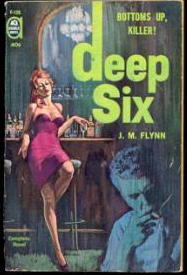 I was doing well enough with legitimate fiction by then to quit the sex-book racket, and I opted to get married and to stay in West Germany. But I continued to correspond with Flynn, and the better I got to know him through his letters (he wrote great letters), the more he intrigued me. I used him as the model for the boozy ex-pulp writer, Russell Dancer, who first appeared in the “Nameless Detective” novel, Undercurrent, in 1973 and who made encore appearances in Hoodwink and Bones. There are a number of differences between Dancer and Flynn, but none of them is fundamental; the lines Dancer speaks in the three “Nameless” novels either were or might have been spoken by Flynn. He stayed in Paris for a while, at LLP’s expense, and then moved to Majorca, at least in part because Wallmann and I had extolled the island’s virtues to him on numerous occasions. He somehow managed to rent the same small villa Jeff and I had occupied in Palma Nova, and stayed there for about a year, getting himself into and out of a series of minor misadventures with LLP (he was fired at least once, briefly, for delivering “unacceptable” material), a group of other LLP writers living on the island, and the owners of several bars and discos. Then his wanderlust got the best of him, and he hied himself off to Monte Carlo, near where Jeff and his girlfriend had moved from Paris. In Monte Carlo, Flynn fell passionately in love with a 25-year-old suicidal West German beautician named Hildegarde. But their romance didn’t last long; she threw him over for a randy Bulgarian and went back to Germany. This so upset Flynn that he, too, fled Monte Carlo. He went first to Ireland, on the mistaken assumption that any writer could live there cheaply and tax-free. When he found out that in order to obtain the tax-free status he would have to exchange his American citizenship for an Irish one, he figured it was time to return to the States. Specifically, to New York to look for writing work, since the bottom was already beginning to drop out of the sex-book market. He took a room in Rosoff’s, an old and now-defunct hotel-and-restaurant on West 43rd just off Times Square, and managed to scrounge up a contract to write several books in the then popular Lassiter paperback western series. The job didn’t last long; he screwed up somehow on one of his manuscripts and was fired. But it so happened that Wallmann arrived in New York just about then, on a business trip; and Jeff, who was doing a book for Belmont-Tower, one of the lower echelon paperback houses, learned that B-T was in need of an assistant editor and house writer. He recommended Flynn, and Flynn got the dual job. 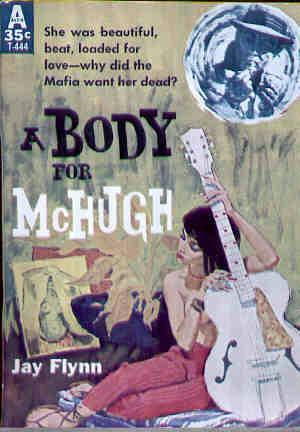 This was 1975. By which time I had been back in the U.S. myself for well over a year, living in San Francisco and also making periodic business trips to New York. So it was in Rosoff’s in early ’75 that Flynn and I finally came face to face. He was shorter than I had envisioned him, less bulky, not at all imposing. No outstanding features, except maybe for a bristly salt-and-pepper mustache. I was vaguely disappointed. Flynn in person was nowhere near as impressive as he was in the abstract. Over the next couple of years we got together every time I went to Manhattan. On one occasion he took me up to see his ex-agent (they were still friendly even though they could no longer work together) because the agent kept a bottle of 30-year-old Scotch for after-hours visitors and why pay for cheap booze, Flynn said, when you could get vintage stuff free? Mostly, though, we sat in the bar at Rosoff’s and drank cheap liquor and talked shop. One of the things we talked about – and wrote each other about from time to time – was collaborating on a novel, but somehow we never got together on a mutually appealing idea. I wish we had; the finished product may not have been much good, but it would have been interesting. Once when I went to see him, he announced that he was on the wagon for good. I asked him why. “Damn croaker said I’d be dead inside a year if I didn’t,” he said. Two days later he was drinking again. But he was still alive and kicking when the year was up. That was Flynn. During his association with Belmont-Tower, he published several novels as by Jay Flynn under their B-T and Leisure imprints – all of them bad. Sexed-up westerns about a World War I-era operative for the Gallows Detective Agency, Jim Bannerman: sexed-up adventure tales featuring a drifter named Venable; sexed-up, violent cop melodramas starring San Francisco police sergeant Joe Rigg. Worst of the lot were the Joe Riggs books. Trouble Is My Business (1976, no apologies to Chandler), about a psycho who chopped off his victims’ heads with a Bowie knife, which Flynn had the puckish audacity to dedicate to Wallmann and me; and Blood on Frisco Bay (1976), a scandalous anti-police diatribe about the murder of a San Francisco socialite. He inscribed my copy of the latter: “For Bill Pronzini – a jolly tosspot [sic] and a hell of a fine friend. After this thing, let on you know me and the S.F.P.D. will have your ass – sit tight.” I took his advice and sat tight. Flynn did publish one reasonably good novel during this period, though it was written a year and a half to two years earlier while he was in Ireland. Warlock (Pocket Books, 1976, as by J.M. Flynn) features psychic detective John Christian Fifer and his 15-year-old daughter, Fiona, a full-fledged, spell-casting witch. Fey stuff, mixing crime and fantasy – not wholly successful, but with some of the same positive energy that made his Ace and Avon novels so enjoyable. I t was supposed to be the first of a series, and in fact he wrote and delivered a second book; but that second manuscript was close to 200,000 words in length and very eccentric, and when Flynn refused to cut or revise a word, his editor rejected it outright and canceled the series. My copy of Warlock carries this inscription: “For Bill Pronzini – who knows where it’s at – from the founder of the Day Late & Dollar Short Writers’ Assn.” 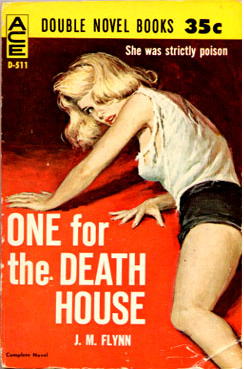 It took Flynn just about
two years to wear out his
welcome at Belmont-Tower, which for him was quite a long time.
One of the reasons for the wear-out was the increasing eccentricity of
the contract novels he delivered; another reason was his failure to
deliver at all on other contracts; a third reason was that he had begun
to foul up on his editorial duties because he was drinking on the
job. His bosses knew he had booze stashed in the office; he would
get increasingly oiled as each day wore on, without ever leaving the
premises. He would also lurch into the john periodically to
freshen his breath from a bottle of Listerine he kept in his
desk. It took them weeks to figure out that he had his booze in
the Listerine bottle and the Listerine stashed somewhere else. It took Flynn just about
two years to wear out his
welcome at Belmont-Tower, which for him was quite a long time.
One of the reasons for the wear-out was the increasing eccentricity of
the contract novels he delivered; another reason was his failure to
deliver at all on other contracts; a third reason was that he had begun
to foul up on his editorial duties because he was drinking on the
job. His bosses knew he had booze stashed in the office; he would
get increasingly oiled as each day wore on, without ever leaving the
premises. He would also lurch into the john periodically to
freshen his breath from a bottle of Listerine he kept in his
desk. It took them weeks to figure out that he had his booze in
the Listerine bottle and the Listerine stashed somewhere else.That was Flynn. After B-T fired him, and he couldn’t find any other contract or editorial work, he quit New York and the writing business for good. The first place he went was to Richmond, Virginia, for reasons that never were quite clear to me. Inside of a year he was broke and living on Richmond’s skid row, where he fell in with a bunch of white-lightning bootleggers; for a time he ran an illegal “nip shop” for them in the rear of a neighborhood barbershop. Then, also for obscure reasons, he quit the bootleggers and took a legit job as a uniformed security guard – a job that required him to carry a handgun. One night during a heavy rainstorm, drunk on white-lightning or the like, he noticed that the ceiling of his furnished room was bulging strangely. Maybe he thought he had the DTs and demons were coming after him; maybe he was just too drunk to know what he was doing. In any event he grabbed up his revolver and pumped five shots into the ominous bulge. Whereupon the entire ceiling collapsed and the ensuing deluge of trapped rainwater knocked him flat, broke his leg, and almost drowned him. That was Flynn. I had lost touch with him again by this time, but he and Wallmann (who had also returned to the States and was quartered in Eugene, Oregon – still is, in fact) continued to exchange an occasional letter. So I found out that after his leg healed Flynn left Richmond, broke and jobless again, and went to Connecticut, where he talked his ex-agent into letting him live on the agent's estate as a nominal caretaker. He stayed out of trouble there, for the most part, but he still and inevitably managed to wear out another welcome. In February of 1985 he decided to move back to Richmond. But he’d been feeling poorly, he wrote Wallmann just before he left, and so he intended to put himself into a V.A. hospital en route for a checkup. He never got back to Richmond because he never got out of the hospital. Within a week of his admission, he was dead. Ironically, it wasn’t the booze that killed him; the damn croakers never did get that right. It was cancer. A tumor the size of a beer bottle. Doesn’t seem possible, but he was still a relatively young man, still in his fifties. Wallmann and I each thought he was that age the first time we met him, thirteen and ten years earlier. Yeah, Jay Flynn was a character. The tragicomic variety, with accent on the tragic. This article first appeared in Mystery Scene #13. Copyright © 1988 by Bill Pronzini. BIBLIOGRAPHY,
compiled by Steve Lewis
FLYNN, J(ohn) M. (ca.1927-1985) All are paperback originals except as noted. The Deadly Boodle.
Ace Double D-313, 1958.
Drink with the Dead. Ace Double D-379, 1959. Terror Tournament. Mystery House [hardcover], 1959. Paperback reprint: Ace Double D-409 [abridged]. The Hot Chariot. Ace Double D-447, 1960. Ring Around a Rogue. Ace Double D-459, 1960. One for the Death House. Ace Double D-511, 1961. The Girl from Las Vegas. Ace Double F-111, 1961. Deep Six. Ace Double F-125, 1961. The Screaming Cargo. Ace Double F-130, 1962. SurfSide 6. Dell 8388, October 1962. [TV tie-in.] Warlock. Pocket Books 80478, 1976. Danger Zone. Belmont-Tower 51171, 1977. – As by JAY FLYNN. All are paperback originals. McH = McHugh. JR = Joe Rigg. B = Bannerman. McHugh. Avon T-377,
1959. McH
It’s Murder, McHugh. Avon T-406, 1960. McH A Body for McHugh. Avon T-444, 1960. McH Viva McHugh. Avon T-466, 1960. McH The Action Man. Avon T-500, 1961. The Five Faces of Murder. Avon F-156; 1962. McH Blood on Frisco Bay. Leisure 360, 1976. JR Trouble Is My Business. Leisure 384, 1976. JR Bannerman. Leisure 389, 1976. B Border Incident. Leisure, 1976. B – Western novels [unverified]
According to James Reasoner, Flynn has been credited with the following
novels in the Lassiter series:
Lust for Gold,
as by Jack Slade. Belmont-Tower 51127, 1977.
Hangman, as by Jack Slade. Belmont-Tower 51146, 1977. Wolverine, as by Jack Slade. Belmont-Tower 51225, 1978. Big Foot’s Range, as by
Jack Slade. Belmont-Tower 51428, 1979.
James continues: “Whether or not he actually wrote them is
anybody’s
guess, but at least one of them is copyrighted in his name. I’ll have to get the books
out to check which one. I’ve read the first three, which form a
loose trilogy, and I think they’re all definitely by the same
writer. I’ve
never read Big Foot’s Range,
so I don’t know
about it. That’s an intriguing title, though, so I may
have to dig it out and read it. Flynn’s only other Western work that I’m aware of are the two
Bannerman books, Bannerman
and Border Incident, which
Bill mentions in his article.”– Short story: “The Badger Game,” as by Jay Flynn. Guilty Detective Story Magazine, November 1956. References: Michael L. Cook, Monthly Murders.
Allen J. Hubin, Crime Fiction IV. Bill Pronzini, “Forgotten Writers #1 : Jay / J.M. Flynn.” James Reasoner, personal email. www.abebooks.com _____________________________________ YOUR COMMENTS ARE WELCOME. stevelewis62 (at) cox.net
Copyright © 2005 by Steve
Lewis. All rights reserved to contributors.
Return to
the Main Page.
|